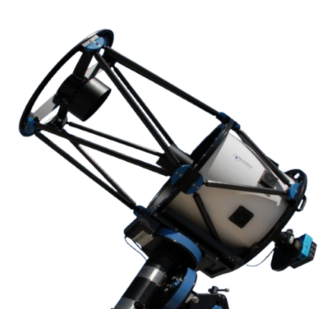Advertisement
Quick Links
Advertisement

Summary of Contents for PlaneWave CDK Series
- Page 1 PlaneWave CDK Telescope Instructions CDK12.5, 17, 20 and 24 V112712...
- Page 2 PlaneWave Instruments. The secondary mirror is movable to allow fine collimation and to set the spacing between the primary and secondary. To get the best performance out of the CDK optical system, the optics must be collimated and the primary-to-secondary mirror spacing must be set.
- Page 3 Figure 3: On the left is the 2” adapter for the CDK12.5 attached to the Secondary Spacer and the Ronchi Ocular. On the right is the 2” adapter for the CDK17, the CDK20 and the CDK24 attached to the Secondary Spacer and the Ronchi Ocular. Step 1, Rough Collimation: a.
- Page 4 Figure 5: An example of an approximately collimated defocused star. The CDK20 uses three ¼-20 socket head cap screws for collimation, as shown in Figure 6. These screws require a 3/16 Allen wrench. The CDK12.5 and the CDK17 have four knobs which can be adjusted by hand, as shown in Figure 7.
- Page 5 Collimation knobs Central Secondary Spacing Bolt Figure 7: The CDK12.5 collimation screws and the central secondary spacing bolt. The CDK17 mechanism is identical to the CDK12.5. Collimation knobs Spacing knob Figure 8: The CDK24 collimation screws and the central spacing knob. Collimation adjustments use the three outer knobs.
- Page 6 behind the fully racked in focuser. The Secondary Spacer places the Ronchi screen of the Ronchi Ocular precisely where the focal plane is supposed to be. About the Ronchi Test Figure 9 illustrates the basic idea behind using a Ronchi grating to identify the position of the focal plane.
- Page 7 Ronchi is nulled (you can see no lines, or one Ronchi line covers the entire aperture; see Figure 10), this means that your spacing is already set; you may proceed to Step 3. This is not uncommon because the primary-to-secondary spacing is set at PlaneWave and you most likely will not need to adjust it.
- Page 8 For every one unit the secondary spacing is changed on the CDK12.5/17, the focal plane moves 7.5 units. You want to keep the error at the focal plane to 5mm or better, which equals just under two lines on the Ronchi. This corresponds to an error in primary-to- secondary spacing of about +/- .7mm.
- Page 9 you need to move the secondary mirror away from the primary. If the number of lines grows as you slide the Ronchi out of the spacing tube, the focal plane is too far forward and you need to move the secondary toward the primary. For every one unit the secondary spacing is changed, the focal plane moves five units.
-
Page 10: Back Focus
Table 1: Shows the back focus with and without the focuser installed for the various PlaneWave telescope models. *The CDK700 is referenced, not from the backplate of the telescope, but from the end of the altitude hub which is the mounting surface for the optical train. - Page 11 Figure 11: The CDK24 has more back focus than the other CDK models, so a spacer is used to put the focuser the same distance from the focal plane as the other CDK models. This means the same spacers will work with all the different models, with exception of the CDK12.5.




Need help?
Do you have a question about the CDK Series and is the answer not in the manual?
Questions and answers